Course Description:
Fluid-applied roof coatings can be applied as a new roof system on a new roof deck or in a maintenance situation as a re-roofing system over an existing deck. They have many benefits, but they are most commonly used to prolong the life of an existing roofing system and to achieve a reflective roof. This course will examine the different types of fluid-applied roof coatings, as well as their advantages, applications, surface preparation techniques, and reflective roofing requirements.
Learning Objectives
At the end of this program, participants will be able to:
- Identify the different types of fluid-applied roof coatings.
- Explore the advantages and applications of fluid-applied roof coatings.
- Examine appropriate substrates and surface preparation techniques for fluid-applied roof coatings.
- Describe reflective roofing requirements and how fluid-applied roof coatings can be used to achieve a reflective roof.
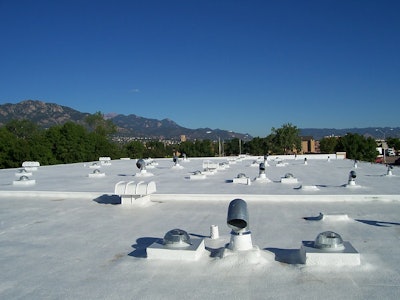
Introduction to Fluid-Applied Roof Coatings
Note: The terms liquid-applied and fluid-applied roof coatings are often used interchangeably.
Though there are many different types of liquid roofing products on the market, this course is going to focus on those products that qualify as a roof coating. It is important to note that a liquid-applied roofing membrane or coating can itself be the exterior weathering surface, or it may be coated with another UV and weather stable layer.
The National Roofing Contractors Association (NRCA) draws a distinction between what is considered a coating and a liquid-applied roof membrane. According to The NRCA Roofing Manual: Membrane Roof Systems—2019:
Liquid-applied roof membranes are constructed in place from a liquid resin and reinforcing material. The liquid resin is available as a one- or two-component product and is typically applied in two coats. Depending on resin chemistry, a catalyst or hardener may be added to induce the curing process. In most instances, a primer is required. Liquid-applied roof membranes are typically reinforced with polyester fleece or fiberglass mat that is set into the resin base coat. The reinforcing material provides the membrane’s crack-bridging ability and much of its mechanical strength. Liquid-applied roof membranes may be surfaced with aggregate (e.g., sand, mineral, ceramic granules), coatings, or sealers. The liquid material cures to form a monolithic weatherproof membrane. Single-component resin eliminates the need for combining products at the job site. Two component materials require proper mixing at the job site and have a limited pot life after mixing.
The NRCA Roofing Manual also says: Liquid-applied roof membranes are more widely known to be used as waterproofing systems but have gained in popularity as roof systems, especially in reroofing situations. However, if a liquid-applied roof membrane does not have reinforcement, it typically is considered a coating system. A reinforced liquid-applied roof membrane is considered by NRCA to be a roof system.
Therefore, a one or two coat liquid-applied roof membrane and a roof membrane with a weatherable topcoat can both be considered a roof system. A liquid roofing product with reinforcement such as fleece or other geotextile material is considered a membrane; if there is no reinforcement it is considered a coating. While reinforcement can be important to a roof system, it is worthwhile to consider the physical properties of liquid-applied roof coatings with and without reinforcement, as the physical properties can help determine what products are best suited to a specific application.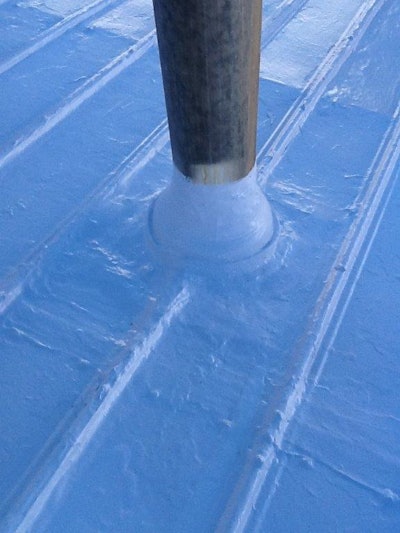
Benefits of Fluid-Applied Roof Coatings
Fluid-applied roof coatings can be applied as a new roof system on a new roof deck or in a maintenance situation as a re-roofing system over an existing deck. They have many benefits, but they are most commonly used to prolong the life of an existing roofing system whether it is an EPDM or TPO sheet membrane or another fluid-applied roofing system.
These systems contribute to the sustainability of the building structure by extending the life of the existing roof surface and preventing unnecessary roof tear off’s, which contribute a great deal of waste to landfills. If properly maintained, you may never have to tear off the existing roof membrane and a renewable coating can be reapplied every 5 to 15 years.
In addition, reflective coatings are often applied over darker colored or aged reflective existing roofs to help reduce energy costs. Fluid-applied coatings provide a seamless, monolithic surface that is fully adhered so that water cannot migrate beneath the surface. These coatings are lightweight, often less than 1/3 pounds per square foot, are self-flashing, and may qualify for immediate tax advantages based on prevailing tax code in your region related to energy saving building upgrades.
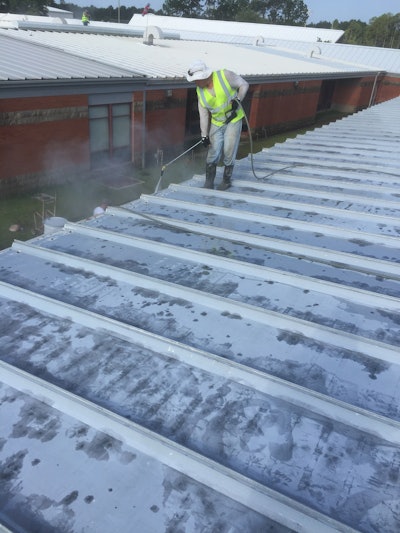
Potential Substrates
When choosing a liquid-applied coating for your project, it is important to consider the existing substrate. Liquid-applied coatings can be installed over virtually any type of surface, from thermoplastic single-ply membranes such as PVC or thermoplastic polyolefin (TPO), to thermoset single-ply membranes such as ethylene propylene diene terpolymer (EPDM), or chlorosulfonated polyethylene (CSPE-Hypalon). They can also be installed over metal, concrete, built-up roof (BUR), modified bitumen (MB), or spray polyurethane foam (SPF).
Surface Preparation for Successful Application
While fluid-applied coatings can be applied over almost any substrate, it is important to note that surface preparation is critical for their success and longevity. Fluid-applied coatings are not to be installed over failed or failing roofs. Deficiencies such as blisters, wrinkles, and ponded water conditions must be repaired, as a clean, dry, sound, and secure surface is required prior to the installation of a fluid-applied coating.
An infra-red (IR) roof scan or core cuts can help to determine if the roof is a good candidate for a fluid-applied coating, as they can identify problems that are not readily visible to the naked eye. Wet and/or damaged areas identified by an IR scan or core cuts must be removed and replaced with like insulation and coating. Each substrate should be washed with a bio-degradable detergent and appropriate power washing or scrubbing equipment. Be sure to consult the manufacturer of the sheet goods to determine how long you should wait to install a fluid-applied coating over new sheet goods.
Priming Substrates
While priming is not required on all surfaces, it can be a critical component to a successful fluid-applied coating installation. Primers are often used to enhance adhesion between the fluid applied coating and the substrate, as well as bind small amounts of dirt, seal porous substrates, and inhibit corrosion of metal substrates. Finally, primers are used to darken substrates to reduce small amounts of residual moisture, as the darker surface will absorb more heat and dry faster. Be sure to consult the manufacturer to determine whether or not a primer is required.
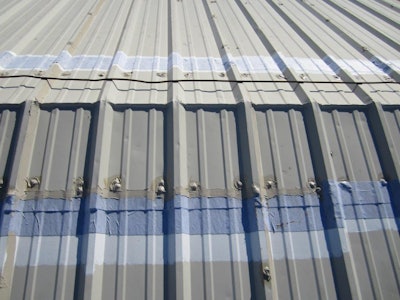
Seam Treatment
For granulated cap sheets and some single-ply membranes, it is good practice, and sometimes even required, to pre-treat the seams with a layer of base coat and a reinforcement fabric before the liquid-applied system is installed. An additional flood coat may also be required to encapsulate the granules on the roof before building the liquid-applied system.
Self-adhered flashing tapes may also be used for detailing penetrations and seams. Whether to use a self-adhered tape or extra base coat and reinforcement is typically the contractor’s choice.
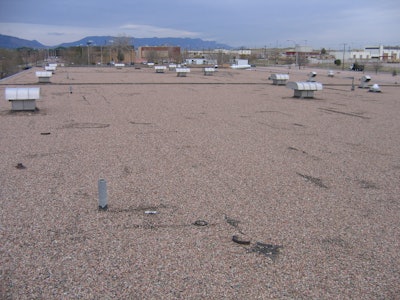
System Selection Criteria
System selection criteria is probably the most important discussion for a specifier, as there are many different types of liquid-applied roof coatings and choosing the right product for a project deserves careful consideration to avoid problems or premature failures. The liquid-applied coatings that we will cover here include aluminum, acrylic, asphalt emulsion, polyurea, silicone, SEBS, and polyurethane.
Aluminum Coatings
Aluminum roof coatings are typically formulated with asphalt, aluminum paste, moisture scavenger, fillers, hydrocarbon solvents, and in some cases, fibers. The overall quality of aluminum roof coatings can be judged by the total quantity of leafing aluminum pigment content per gallon. While aluminum roof coatings are relatively easy to install and provide good sun protection to the existing roof membrane, they come with very limited warranties, no real waterproofing capacity, minimal solar reflectance, and must be regularly maintained every two to three years in order to function properly.
Acrylic Coatings
Acrylic coating systems are based on acrylic resin and are generally a latex-based system that cures by air drying. Acrylic coatings are amongst the easiest to apply. They are low odor, low cost, and have excellent color retention, as well as UV and weather resistance with very good initial solar reflectance.
Multiple coats can be applied on hot days, but on the down side, they cannot be applied below 32 degrees or if rain or dew are imminent. Acrylic coating systems have low tensile strength and are not appropriate for high traffic areas or where ponding water is a problem. They are also not chemical resistant, cannot be applied in heavy mils, and have extended cross-linking time. However, when used appropriately, acrylics can greatly enhance the appearance of a roof.
Asphalt Emulsion
According to the Handbook of Accepted Roofing Knowledge (HARK) Manual, asphalt emulsion is, “A mixture of asphalt particles and an emulsifying agent such as bentonite clay and water. These components are combined by using a chemical or clay emulsifying agent and mixing or blending machinery.”
Emulsions are user friendly and provide good water resistance. However, they are also temperature dependent, cannot resist the high movement of modern buildings, have somewhat of an odor and require protection and reinforcement for superior longevity. They are also dark in color so they will cause the roof to heat up when exposed to sunshine.
Polyurea Snap Cure Systems
Polyurea coatings are either solvent based or 100% solids, depending on the formulation, are typically two-component, and cure to form films with limited elongation and high tensile strength.
Polyurea coatings can be applied in heavier single passes up to 40 mils thick and can be applied to vertical surfaces with significant film build. Spray-applied base and top coats can be applied the same day, providing quick return to service with very durable physical properties and low VOCs. These coatings can be rained on or walked on often within minutes of application.
However, polyureas can have adhesion issues and suffer significant loss of physical properties over time due to UV degradation. Plural component equipment is very expensive and a good application is heavily dependent on the applicator, more than with other fluid-applied coatings. There is potential for an off-ratio mix if the equipment experiences issues, and there is significant overspray risk.
Silicone Inorganic Coatings
Silicone is an inorganic coating derived from silicone polymer that is available in single or plural components. Silicone inorganic coatings have high moisture vapor permeability and are classified as breathable coatings.
Silicones provide excellent weathering ability and UV resistance and retain their physical properties well. The biggest issue with silicone is compatibility with other coatings, as it will only stick to silicone and is therefore not a good candidate for re-coats. Granules may be added for abrasion resistance, mechanical activity, and aesthetics. Silicones have good initial solar reflectance, but due to their surface tackiness can pick up dirt from the atmosphere relatively quickly and lose reflectance.
Styrene Ethylbutylene Styrene (SEBS)
Styrene ethylbutylene styrene (SEBS) is a single component elastomeric coating made from rubber polymer that cures when the solvent evaporates and leaves a rubber film. They offer excellent adhesion, high elongation at 600 to 800 percent, and are good in ponding water conditions. SEBS may be applied on a variety of substrates, but primer is only required on modified bituminous and BUR roofs.
SEBS are limited by low solids content in the 50 to 60 percent solids range, meaning they have a high concentration of solvents, which is required to reduce viscosity to a workable level. Additionally, they have a strong odor, high cost, and are difficult to apply in low temperatures or high humidity.
BEGIN CASE STUDY
Building Leasing Company Rental Building
Ulysses, Kansas
Coating System Used:
· 70620 one component moisture curing aromatic polyurethane basecoat
· 7490 one component moisture curing aliphatic polyurethane topcoat
Structure Age: Approximately 1972
In 2008 large hail from a damaging hail storm dented the surface of the 26 gauge metal R-panel roof on the Building Lease Company’s rental building in Ulysses, Kansas. When dents hit the metal overlap seams it created fish mouth protrusions that can cause leaks. Insurance allows two methods of repair:
1. Remove and retrofit the metal or
2. Apply a coating to the existing metal to seal damages
Applying a coating was the less expensive and more sustainable choice. Mike Anderson of Skylite Construction, Inc. noted, “We were able to retain the existing metal substrate, avoid sending removed damaged metal panels to landfill, and did not have to create new panels.”
The owner wanted a manufacturer-backed performance coating to seal the roof. Neogard provided the solution with their Elasta-Gard M aliphatic polyurethane system with a warranty. This system makes the roof seamless and completely monolithic. Skylite Construction Inc. is a certified applicator of Neogard products.
The attributes desired by the client were adhesion to the existing metal roof and seam, joint sealants, and longevity as defined by a 10-year warranty.
The job application entailed 12,000 square feet of roof. Surface prep included pressure cleaning, applying urethane caulking on all horizontal/vertical seams and every fastener, and applying a base coating with embedded polyester fabric along edges and around penetrations. Project specifications were followed to receive a joint Neogard Applicator (Skylite Construction Inc.) 10-year Labor & Material Warranty and the job was inspected after completion by a Neogard sales representative for approval. 10-year warranty requirements were:
· Apply black 70620 series aromatic polyurethane coating to prepared roof surface to yield an average thickness of 15 dry mils.
· Topcoat the black aromatic polyurethane coating with a light gray 7490 series aliphatic polyurethane coating to an average thickness of 10 dry mils for an overall minimum thickness of 25 mils.
This project is nearing 12 years, with an inspection performed August 2018, and the coating is performing exceptionally well. The coating shows no signs of age related issues of cracking or splitting and there is no delamination.
According to the Skylight Construction Inc. applicator, there have been two additional hail storms since the application of Elasta-gard M system, and as stated above, the inspections revealed no new damage. From the building owner and the insurance adjusters perspective, they were very pleased with the impact performance because it avoided an insurance claim.
Following are the properties of the base and topcoat.
70620 basecoat:
· Tensile Strength, ASTM D412, 1,022 psi
· Elongation, ASTM D412, 539%
· Permanent Set, ASTM D412, < 5%
· Tear Resistance, ASTM D1004, 1.35 (lbs-force)
· Water Resistance, ASTM D471, < 3% (7 days)
· Shore A Hardness, ASTM D2240, 70–75
· Taber Abrasion ASTM 4060, 7.5 mg (1,000 CS-17)
7490 topcoat:
· Tensile Strength, ASTM D412, 2,300 psi
· Elongation, ASTM D412, 230%
· Permanent Set, ASTM D412, 10%
· Tear Resistance, ASTM D1004, 200 pli
· Water Resistance, ASTM D471, <2% (7 days)
· Taber Abrasion, ASTM D4060, 16 mg (1,000 CS-17)
· MVT (20 mils), ASTM E96, 0.9 perms
· Shore A, ASTM D2240, 85
· Fire Resistance, ASTM E108, Pass (as part of a tested system)
END CASE STUDY
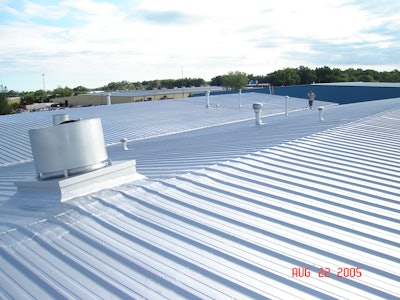
Polyurethane Coatings Overview
During the late 1930's, Otto Bayer pioneered the chemistry of polyisocyanates, a technology that led to the advent of polyurethanes for a variety of applications. Due to their ability to vary physical properties such as hardness, elongation, abrasion resistance, and modulus, polyurethanes are widely used in a variety of materials. These include foams for building insulation and seating, adhesives for construction and specialty applications, textile fibers for clothing and consumer products, thermoplastics for automotive and general industrial parts, and coatings for a variety of substrates and applications. Polyurethane coatings used in the building, infrastructure, and architectural markets, which we are discussing here, fall under this category.
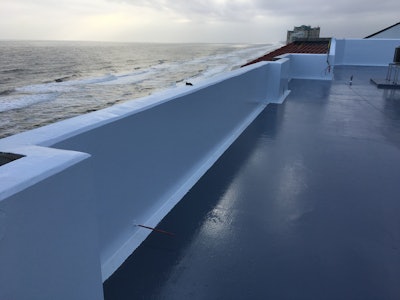
Polyurethane Performance Attributes
Polyurethanes are one of the most durable coatings on the market today and have found application in the corrosion and construction protection markets because they provide a unique combination of flexibility, weatherability, as well as chemical, abrasion, and corrosion resistance. These coatings also provide reduced VOC emissions, superior coating thickness, and edge retention. A well-formulated coating provides the advantage of fewer required coats, reducing cost per application by reducing labor, and the higher level of performance requires less surface preparation and the ability to self-prime. Furthermore, polyurethanes have faster curing times, allowing for increased productivity and driving their widespread acceptance across the protective markets.
Polyurethane coatings come in both single component (moisture cure) and plural component (chemical cure) systems with different speeds of reactivity. Single component polyurethanes are moisture cured and offer longer working life, while plural component products have a standard-to-fast cure time, limiting the window of opportunity when installing. However, the faster cure time provides a faster finish, which limits defects due to rain or environmental contaminants such as leaves or insects.
The solids content of polyurethane coatings is typically medium to high. High solids coatings have little to no solvent in their composition and were first introduced to comply with increasingly stringent VOC regulations. Due to this increased solids content and lack of solvent, these coatings must be formulated differently than those with low solids. The removal of solvents, which are used in traditional coatings to compensate for viscosity, flow, and curing, require the new coatings to have different characteristics and methods of handling.
In many cases, catalysts as well as other modifiers such as flow and leveling agents, solvents, and anti-corrosion and extender pigments may also be used to formulate a complete commercial coating. Raw material suppliers have developed lower viscosity resins and methods for coating formulators to employ to allow for user-friendly roof coating systems.
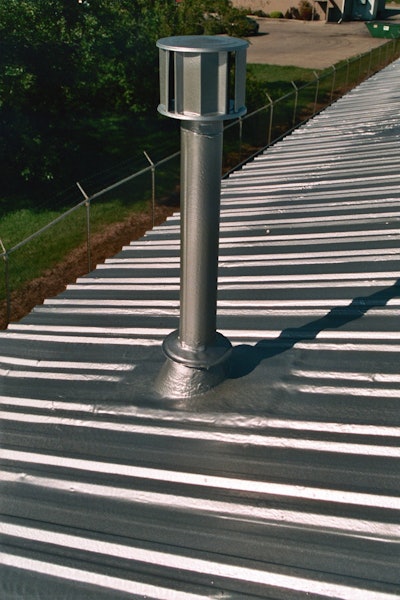
Polyurethanes—Aromatic vs. Aliphatic
Polyurethane roof coatings can be grouped into two broad categories, aromatic or aliphatic. Either type can be a single or two-component system. Aromatics have moderate-to-high tensile strength and elongation with medium-to-high solids. They are typically used as a base coat (primer), although some formulations can be used for top coats.
Aliphatic coatings have similar properties as aromatic coatings, but their solids content is generally not as high. Aliphatics are light stable and therefore exhibit excellent UV resistance, and also have excellent color retention. These attributes, along with the coatings’ inherent dirt resistance, allows the coating to have excellent initial and long-term solar reflectance. Because of these superior aesthetic properties, aliphatics are typically used as a top coat but are sometimes employed as a vapor retarder or breathable membrane.
Polyurethanes—Single Component vs. Two Component
Single-component polyurethanes are moisture cured, meaning they react with atmospheric water in the form of humidity to form a polyurethane/polyurea coating. They have medium-to-high solids, can be aromatic or aliphatic, and are also often used as a vapor retarder or breathable membrane depending on the specific formulation.
Two-component polyurethanes are a mixture of resin and hardener, which react with each other and then cure. The cure is standard to fast and therefore requires care in mixing due to their limited pot life. Some coatings may only be sprayed through two-component equipment. Two-component polyurethanes have high tensile strength and resist mechanical damage. They can be either aromatic or aliphatic.
One-component and two-component aromatic and aliphatic polyurethane roof coatings have excellent initial as well as long-term elongation. Some elastomeric roof coatings use plasticizers for flexibility but these can migrate out of the coating after repeated exposure to rain and heat. The long-term elastomeric properties of polyurethane based roof coatings are achieved by the use of reactive resin components that do not leach out over time. This is a key attribute to retain the waterproofing and crack bridging capabilities of a roof coating system.
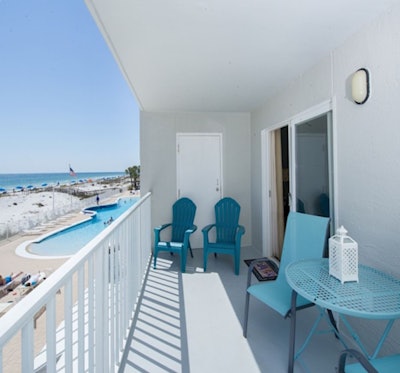
One-Component Moisture Cure Roof Coatings
One-component moisture cure roof coatings are one of the most common polyurethane based liquid applied roofing systems. They are popular since they have a good price and performance balance versus other liquid coating technologies. They are easier to apply than two component polyurea or polyurethane systems since most of the reaction has already taken place in the supplier’s reaction vessels.
A moisture cure coating is made in the coating supplier’s facility by combining the two polyurethane components—a resin blend and an aromatic or aliphatic hardener—under controlled conditions in a reaction vessel. The selection of resin components contributes to their resistance to water, and a range of physical properties such as elongation and hardness can be obtained by varying the resin selection. The finished product is technically called a pre-polymer and is a one-component product that can be applied by the roofing contractor in the field using conventional methods rather than specialized plural component spray equipment.
Moisture cure coatings based on aliphatic hardeners are a relatively new class of coatings compared to other technologies and represent a significant step up in long-term durability, weatherability, and waterproofing. The aliphatic polyurethane technology is similar to the exterior clearcoats used in the automotive industry for excellent long-term color and gloss retention as well as UV and weather resistance. While slightly higher cost than aromatic based coatings, they offer a higher level of in-service performance and longer service life.
A new development allows the use of polyaspartic coating on exterior concrete decks, balconies, and terraces where there is often more concrete movement, cracking, and issues with environmental moisture leaking through the concrete to the area underneath.
Flexible polyaspartic systems can be used as both the waterproofing and top colorcoat in one and will have the following properties:
· 150 – 350% elongation to withstand concrete movement
· Eliminates possible adhesion issues between dissimilar coating layers such as a flexible waterproofing build coat topped with a harder light stable topcoat/wearcoat by using the same coating material for the total coating buildup
· Rain ready in several hours, reducing the chance of damage due to storms after application – no waiting overnight
· Light and weather stable even as it wears, as there is no exposure of a less light stable sub-layer
· Easy-to-use working time allows the material to be mixed and applied using a brush, roller, or squeegee and can accept a broadcast of non-slip additives
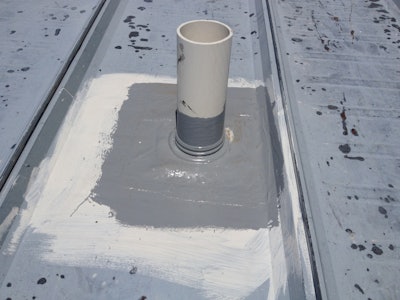
Application of Fluid-Applied Coatings
Fluid-applied coatings can often be tinted to add color to a roof, while aggregate can be added to provide additional protection and texture for slip resistance. Sometimes aggregate and color are used in tandem to create a slip-resistant walkway on the roof. If there are multiple penetrations in a roof a fluid-applied coating can be a great choice, as the product is easily applied around the penetrations to form a seamless monolithic waterproofing barrier.
Determining the best application method for the material is critical. Fluid-applied coatings can be spray applied, roll applied, or brush applied and each has its pros and cons. Often times two or more methods are combined (spray and backroll) which help to provide the best coverage. Rolling is often used if over spray is a problem or wind conditions prevail. A crosshatch technique should be used when spraying for better productivity and more uniform dry film thickness. Brushing is used when trimming out penetrations or architectural details such as parapets, HVAC units, and stacks.
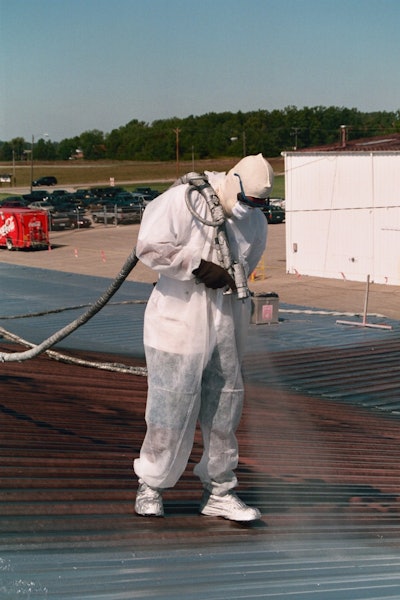
Factors Affecting Proper Selection of Liquid-Applied Roofing Coating
There are several factors to consider in selecting the proper liquid-applied coating including the time of year of application, which will determine the weather, temperature, and humidity. Geography, expected longevity, and use of the roof including mechanical equipment and foot traffic are also important, as are aesthetic considerations. Some may think of roof aesthetics as secondary, but consider that higher buildings surrounding the project will have a clear view of the roof. Flammability and code requirements, cost (life cycle), the mil thickness and slope are also important considerations.
In summary, there are two keys to any successful liquid-applied coating application, surface preparation and dry film thickness. The surface must be exceedingly clean, and seams and penetrations must be properly prepared. The dry film thickness (DFT) can determine the longevity of the roof, as more mils equate to a longer life expectancy. If the right amount of product is not put down, and if the surface is not properly prepared, it can lead to premature roof failure.
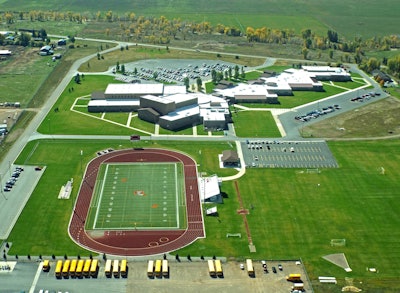
Introduction to Reflective Roof Requirements
Fluid-applied polyurethane roofing systems can be used as a “cool roof coating” to reduce a building’s energy load and extend the life of the roof. Cool colored roofing products are simply conventional roofing materials produced in pigments that have a high solar reflectivity and are minimally heated by the sun. Reflective roofs keep buildings and their surroundings cooler by reducing the fraction of incident sunlight that is converted to heat by the roof. They reduce electricity use in air-conditioned buildings, increase thermal comfort in unconditioned buildings, and reduce the urban heat island effect.
White and tinted roof coatings contain transparent polymeric materials, such as polyurethane or acrylic, and a white pigment, to make them opaque and reflective. These coatings typically reflect 70 to 90 percent of the sun’s energy. The solar reflectance of colored coatings is generally lower than white coatings, but can still reach reflectance as high as 85 percent, particularly lighter colored coatings such as light gray. This is made possible by specific IR reflective pigments which are available in several colors other than white.
Highly reflective colored roofs typically have an initial solar reflectance 0.30 to 0.55, compared with around 0.10 for conventional dark steep-sloped roofs. With a liquid applied coating system, the life expectancy is 5 to 20 years and they can be applied on low- or steep-sloped roofs. As a comparison, a non-cool smooth black coating would have a solar reflectance of 0.05 while a smooth white cool roof would have a solar reflectance of 0.70 to 0.85.
The cool roof options available to a building owner depend in large part on the building and roof type they are working with. That said, there is a cool option for nearly every type of roof and they are relatively easy to implement for commercial buildings. The roofs of most commercial and high-rise residential buildings are low-sloped and are generally not visible from the street. As a consequence, there is little resistance or cost to changing the color of these roofs during routine retrofits or when waterproofing.
That being said, cool roofs must be considered in the context of their surroundings. A bright white roof could reflect into the higher windows of taller neighboring buildings, which may cause uncomfortable glare and heat for those building occupants. Building owners can opt for a cool colored roof with
lower reflectivity to provide some improvement in reflectance without significantly affecting neighboring buildings.
In addition, the success of cool roofs depends on latitude, altitude, annual heating load, annual cooling load, peak energy demands, and sun blockage by trees, buildings, and hills for the particular building. Cool roofs on buildings in some of the northern latitudes may not be appropriate. That said, whether or not a cool roof is appropriate in any climate depends on the building, its energy usage pattern, existing needs, and costs.
Cool Colors
White is the “coolest” color, but there are cool versions of a wide variety of popular colors. Highly reflective roofs can come in many colors such as red, green, and gray. Surfaces that are more reflective tend to remain cooler than those that are less reflective. Both solar reflectance and surface temperature rise should be considered when assessing a cool surface material.
Fluid-Applied Coatings as Reflective Roof Systems
An example of a fluid applied coating that can also qualify as a reflective roof system is a one or two component polyurethane coating. These coatings are formulated with flow and leveling aids, solvents to reduce the working viscosity, and pigments. In the case of roof coatings, the pigment package often utilizes white or light pigments such as titanium dioxide in order to reflect the heat-generating infrared (IR) wavelengths of sunlight off the roof surface.
The benefit of this is two-fold. First, reducing the temperature of the roof reduces the building cooling system energy load, which is why this type of coating is often referred to as a “cool roof coating.” Second, by reducing the temperature fluctuations of the roof, the expansion and contraction of the roof components and infrastructure are lessened, extending the life of the roof and reducing future leakage points. Additionally, some aromatic polyurethane based roof coatings are ablative as they weather in the sun, which is claimed to be beneficial because the IR absorbing dirt that builds up on the surface can wash off when it rains, therefore keeping the roof lighter in color and more reflective. This class of coatings is the topcoat and usually is applied by roller or spray with the latter more common due to the large areas to be coated.
Substrates include aged single ply membranes such as EPDM and TPO, metal, concrete, built-up roof (BUR), and spray polyurethane foam (SPF). Typical thickness is 15 to 20 wet mils per coat, and two coats are commonly applied. The material cure time is dependent on atmospheric moisture and ambient temperature, with lower temperature and/or humidity lengthening the cure time. For this reason, the cure time can vary from 4 to 16 hours. Some manufacturers offer catalysts that can aid the cure in lower temperature or humidity situations.
Some application areas where this class of coating is used include low-slope standing seam metal and spray foam insulated roofs.
CASE STUDY
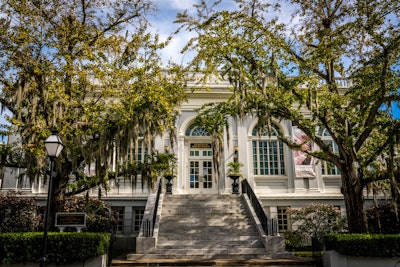
Charleston Library Society
Charleston, South Carolina
Roof Rehab Project Meets Challenge While Staring Down Two Hurricanes
Historic roof rehabilitation projects are not always easy. The historic Charleston Library Society completed a major roof rehabilitation project last year during what became a hyperactive U.S. hurricane season.
Charleston, South Carolina, is no stranger to high winds and heavy rains, so roof waterproofing is critical for protection. In this case, the library, built in 1914, is home to a slice of American history. It is owned by the Charleston Library Society, the third oldest private library organization in the U.S., whose archives encompass an extensive array of southern colonial newspapers, rare books, maps and plats, and manuscript collections including letters from George Washington, Robert E. Lee, Charles Pinckney, and John C. Calhoun.
The design phase of the rehab project began in 2016 after the Society retained Applied Building Sciences, Inc. (ABS) of Charleston to assess the structure and the building envelope. The roof was identified as a priority for Phase 1 of the rehabilitation. The full 10-month project was completed in February 2018, after work was temporarily stopped when Hurricane Irma flooded downtown Charleston and Hurricane Maria threatened a repeat.
One of the most pressing issues for the design team was a low-slope roof at the back of the library covered with an acrylic single-ply membrane on top of many decades worth of archaic built-up roofing (BUR). Water was entrapped in the built-up layers and was beginning to damage interior finishes after wet weather.
The main roof at the front of the building includes a parapet surrounding a slate hip-roof with a skylight along the ridge. The parapets required rehabilitation and waterproofing protection especially at the roof transition and on top. The copings were terra-cotta covered with a piecemeal conglomerate of aged coatings and reinforced membranes. A built-in gutter, a trough that extends from the face of the parapets to the eaves of the hip roof, was also a concern. It contained layers of copper flashings and liquid-applied coatings installed over many decades.
Monolithic Waterproofing
The ABS design team included architect Lauren Ulmer, AIA, registered roof consultant Eddie Polk and structural engineer Jason Gregorie, PE, CFM, senior structural engineer and partner at ABS. Gregorie explained the decision on the waterproofing specification.
“For the gutter, we first looked at relining it with metal, either stainless steel or copper, but we ultimately chose the liquid-applied membrane from Kemper System because of its monolithic nature. For the low-sloped roof at the rear, we considered TPO (thermoplastic polyolefin sheet), but again decided to go with the cold liquid-applied membrane. Eventually, it became a no-brainer because we wanted every area to have seamless monolithic protection.
After initial research on waterproofing materials, Gregorie preferred reinforced aliphatic polyurethane resins over acrylics and silicones, for durability and perforation resistance. He specified an aliphatic polyurethane cool roof system with a Solar Reflectance Index of 110 that is also Class A fire-rated. The reflective roof can lower building cooling requirements, which is important in Charleston where average temperatures top 85oF, June to August.
Jeff Younger, Southeast Region Account Representative for Kemper System, educated the ABS design team about a similar project with the Philadelphia Museum of Art and that became an inspiration, Gregorie said. “The driving force for the library was that we needed a versatile solution to address the varied substrates and surface profiles, the many contours, and the intersecting planes. The roof also had tight working spaces and difficult details for the contractor to work through. We knew the Kemper System could work well. It fully adheres, and the contractor could easily apply it to the different elements and transitions to achieve monolithic protection. A TPO would have been exceptionally more difficult in this case.”
Another important characteristic was that unlike sheet products, which use termination bars, the Kemperol membrane could self-terminate at the top outer edge of the parapet copings. “Since the library is architecturally significant in Charleston, we weren’t allowed to make any aesthetic changes that could be visible from the street,” he explained.
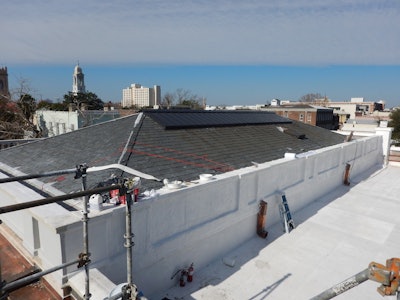
Wind Uplift Testing
Before the liquid-applied roofing assembly could be installed on the low-slope roof, it needed to pass field tests for wind uplift to a design pressure of minus 100 psf. ABS constructed test mockups for preliminary field-pull tests, and the insulated roof assembly, testing to 125 psf using a wind uplift chamber, per FM 1-52. Both tests passed. The full assembly consisted of a repair mortar topping slab on the original concrete deck, two layers of insulation board for slope, cement board, and then the liquid-applied membrane system, which includes a reinforcement textile between the two layers of polyurethane waterproofing resin.
For most other areas, including the built-in gutter, the parapet coping, and the lower part of the parapet wall, Kemperol 2K FR was applied over native masonry, terra-cotta, and concrete substrates without insulation or cement board. ABS field tested those areas in accordance with standard ASTM D-7234 for pull-off adhesion strength. Two component aliphatic polyurethane coatings exhibit excellent adhesion to a variety of surfaces which was a plus for this project’s different substrates.
For Cahill Contracting there were at least two major challenges to finishing the project—surface preparation and the threat of hurricanes. Cahill was using a scaffold tent to keep work areas dry, but with the potential of tropical-storm force winds in the forecast from Hurricane Irma the following week in mid-September, they needed another plan.
The solution was to finish or close any open repairs, and apply a temporary single-ply on the unprotected lower roof, and Kempertec® primers to other surfaces ahead of the storm. Owner Chris Cahill made the call. “This is a historic building and some of those books are irreplaceable. So our crews worked over the weekend and put in a lot of overtime to get it done.”
About 10 days later, weather threatened again as Hurricane Maria barreled north about 300 miles off the South Carolina coast. Fortunately, it took a hard right east of Cape Hatteras, N.C. and fizzled into a tropic storm. Charleston experienced some wind, but less rain and no flooding.
In early October, when surfaces were thoroughly dry and with no rain in the forecast, the crew applied the Kemperol Reflect 2K FR aliphatic polyurethane system, which has an open time of about 30 minutes. The reinforced membrane system is applied a section at a time, and dries to a monolithic surface that is water-resistant after about two hours.
To receive credit please complete the quiz below. 70% is required for a passing grade. You may retake the quiz as needed.
Glossary
LIQUID-APPLIED ROOF MEMBRANE
Constructed in place from a liquid resin and reinforcing material; a reinforced liquid-applied roof membrane is considered by NRCA to be a roof system
INFRA-RED (IR) ROOF SCAN
Can help to determine if the roof is a good candidate for a fluid-applied coating, as they can identify problems that are not readily visible to the naked eye. Wet and/or damaged areas identified by an IR scan or core cuts must be removed and replaced with like insulation and coating
AROMATIC HARDENER
A reactive component of a two component coating system with an amber to brown color. An aromatic hardener reacts with the resin side to produce a coating film that is not light stable and will yellow over time when exposed to sunlight or ambient light sources
ALIPHATIC HARDENER
A reactive component of a two component coating system that is water-clear. An aliphatic hardener reacts with the resin side to produce a coating film that is very light stable and will not yellow over time when exposed to sunlight or ambient light sources
ONE-COMPONENT (1K) COATING
Moisture cured coating, meaning they react with atmospheric water in the form of humidity to form a polyurethane/polyurea coating. They have medium-to-high solids, can be aromatic or aliphatic, and are often used as a vapor retarder or breathable membrane depending on the specific formulation
TWO-COMPONENT (2K) COATING
A mixture of resin and hardener, which react with each other and then cure. The cure is standard to fast and therefore requires care in mixing due to their limited pot life. Two-component polyurethanes have high tensile strength and resist mechanical damage. They can be either aromatic or aliphatic
MOISTURE CURE COATING
Made in the coating supplier’s facility by combining the two polyurethane components—a resin blend and an aromatic or aliphatic hardener—under controlled conditions in a reaction vessel. They are a relatively new class of coatings compared to other technologies and represent a significant step up in long-term durability, weatherability, and waterproofing.
DRY FILM THICKNESS (DFT)
The thickness of a coating as measured above the substrate after the coating dries. Thickness of a coating depends on the application and type of process employed. The dry film thickness can determine the longevity of the roof, as more mils equate to a longer life expectancy
COOL COLORED ROOFING
Conventional roofing materials produced in pigments that have a high solar reflectivity and are minimally heated by the sun
ABLATIVE
Aromatic polyurethane based roof coatings are ablative as they weather in the sun, which is claimed to be beneficial because the IR absorbing dirt that builds up on the surface can wash off when it rains, therefore keeping the roof lighter in color and more reflective
Company Blurb
As an innovation leader in the development of high performance coating and sealant raw material technologies, Covestro, LLC enables architects, designers and building owners by providing real world solutions for built environment challenges. Covestro, LLC develops coating and sealant solutions for flooring, interior and exterior walls and trim, and roofing and waterproofing with high performance and sustainability in mind.